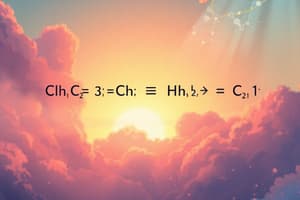Podcast
Questions and Answers
What is the purpose of a chemical equation in representing a chemical reaction?
What is the purpose of a chemical equation in representing a chemical reaction?
To illustrate the transformation of reactants into products
According to Dalton's atomic theory, how do chemical reactions involve the rearrangement of atoms?
According to Dalton's atomic theory, how do chemical reactions involve the rearrangement of atoms?
Atoms from reactants rearrange to form products
Explain the importance of maintaining the equality of atoms of each element on both sides of a chemical equation.
Explain the importance of maintaining the equality of atoms of each element on both sides of a chemical equation.
To uphold chemical laws
Differentiate between reactants and products in a chemical reaction.
Differentiate between reactants and products in a chemical reaction.
What does an arrow in a chemical equation represent?
What does an arrow in a chemical equation represent?
List three types of chemical reactions mentioned in the text.
List three types of chemical reactions mentioned in the text.
Flashcards are hidden until you start studying
Study Notes
Rasayanik Abhikriya (Chemical Reactions)
Chemical reactions occur when reactants transform into products through chemical bond formation and breaking. They are essential processes in various fields, such as industry, biochemistry, and daily life. According to Dalton's atomic theory, chemical reactions involve rearrangement of atoms from reactants to form products, resulting in conserved mass and energy. A chemical equation is used to represent a chemical reaction, showing reactants on the left side and products on the right side, separated by an arrow. The number of atoms of each element must be equal on both sides to maintain chemical laws.
Reactants are substances that enter a chemical reaction, and products are substances formed by a chemical reaction. An arrow indicates the conversion of reactants into products, representing the flow of a chemical reaction. Different types of chemical reactions exist, such as combination, decomposition, single displacement, double displacement, neutralization, hydrolysis, combustion, precipitation, and acid-base reactions.
AVN Samikaran (Chemical Equations)
Chemical equations visually depict chemical reactions, listing reactants on the left side and products on the right side. Equations are crucial for studying chemical reactions since they illustrate the transformation of reactants into products. A balanced chemical equation ensures that the number of atoms remains unchanged before and after the reaction, thus maintaining the law of conservation of matter.
Balancing a chemical equation involves adjusting the stoichiometry so that the ratio of atoms of each element matches on both sides of the equation. Chemical equations display reactions physically and mathematically, allowing scientists to analyze the components of a reaction and predict outcomes.
In summary, chemical reactions involve the conversion of reactants into products via chemical bond rearrangements. Chemical equations graphically portray these conversions, ensuring that the number of atoms stays consistent throughout a reaction. Understanding chemical equations helps researchers to study and predict chemical reactions.
Studying That Suits You
Use AI to generate personalized quizzes and flashcards to suit your learning preferences.




